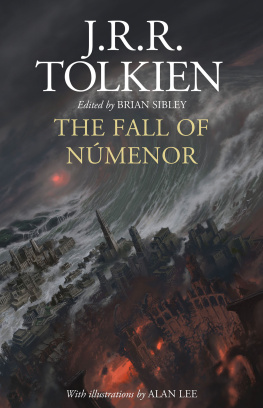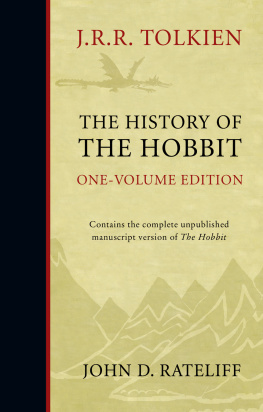The Body in Tolkiens Legendarium
Essays on Middle-earth Corporeality
Edited by Christopher Vaccaro

McFarland & Company, Inc., Publishers
Jefferson, North Carolina, and London
LIBRARY OF CONGRESS CATALOGUING DATA ARE AVAILABLE
BRITISH LIBRARY CATALOGUING DATA ARE AVAILABLE
e-ISBN: 978-1-4766-0388-9
2013 Christopher Vaccaro. All rights reserved
No part of this book may be reproduced or transmitted in any form or by any means, electronic or mechanical, including photocopying or recording, or by any information storage and retrieval system, without permission in writing from the publisher.
Cover illustration 2013 iStockphoto
McFarland & Company, Inc., Publishers
Box 611, Jefferson, North Carolina 28640
www.mcfarlandpub.com
Table of Contents
Christopher Vaccaro
Verlyn Flieger
Yvette Kisor
Anna Smol
Matthew Dickerson
Jolanta N. Komornicka
Robin Anne Reid
Gergely Nagy
James T. Williamson
Jennifer Culver
Christopher Vaccaro
Abbreviations
All citations from The Lord of the Rings will be by book and chapter and page number as they are located in the editions listed below.
FR: The Fellowship of the Ring. London: George Allen & Unwin, 1954; Boston: Houghton Mifflin, 1954. 2d ed., Boston: Houghton Mifflin, 1987.
Hobbit: The Hobbit. London: George Allen & Unwin, 1937. Boston: Houghton Mifflin, 1938. The Annotated Hobbit, 2d ed., rev., ed. Douglas A. Anderson. 2d ed. Boston: Houghton Mifflin,
2002.
Letters: Carpenter, Humphrey, ed. The Letters of J.R.R. Tolkien. Boston: Houghton Mifflin, 2000.
RK: The Return of the King. London: George Allen & Unwin, 1955; Boston: Houghton Mifflin, 1956. 2d ed., Boston: Houghton Mifflin, 1987.
Sil: The Silmarillion, ed. Christopher Tolkien. Boston: Houghton Mifflin, 1977.
TT: The Two Towers. London: George Allen & Unwin, 1954; Boston: Houghton Mifflin, 1955. 2d ed., Boston: Houghton Mifflin, 1987.
Introduction
Christopher Vaccaro
It is a fallen world, and there is no consonance between our bodies, minds, and souls.
How many white wizards fit on the head of a pin? Does the same divine music present at the moment of Ardas creation also resonate within the limbs of Pippin and Sam Gamgee, the Sung Word ensconced in flesh? Did the sculptors of the Argonath strive for physical realism or (as is more likely) did they attempt to convey Isildurs and Anarions virtues through a culturally recognized and highly symbolic palette of facial and bodily features? Is Frodos tortured shirtless back a site upon which the orcs of Cirith Ungol inscribe Saurons temporary power and marred morality? All of these enquiries are meant to steer thoughts toward this one question: Do bodies matter in Middle-earth? To the contributors of The Body in Tolkiens Legendarium, the answer is an unqualified Yes.
Tolkiens emphasis on the spirit (fa) seemed to demand from him a continuous downplaying or sublimation of the physical (hra). As much as he wrote of the beauty of Arda, he often upstaged this creation through his continuous emphasis on the spirit. This is made more apparent by his linking of the material world of Arda to Morgoth.
The critical collections on Tolkiens texts published recently have made considerable gains in reaching beyond formal, source-specific interpretations, and many of the essays within Tolkien the Medievalist,J.R.R. Tolkien and His Literary Resonances, Tolkiens Modern Middle Ages, and Tolkiens Legendarium: Essays on The History of Middle-earth, and the Tolkien Studies journal provide significant contextual frameworks for an analysis of corporeality though none provide scholarship dedicated to the subject. In fact, until now no collection has made a direct case for the bodys prominent place in Tolkien scholarship. From this focused interpretive trajectory, scholars may find their interpretations of the Legendarium centered upon a bevy of relevant issues (birth, decay, resurrection, physical discipline, pain, suffering, torture, sickness, hunger, shape-shifting, and more broadly metamorphoses), central binaries (fertility/celibacy, purity/pollution, transparency/translucence, spirituality/materiality, absence/presence, and mortality/immortality), and hitherto untreated subjects (iconography, bodies within the source material, dance, nutrition, and even exercise).
Essays touching upon subjects of race, gender, and sexuality naturally direct the critical conversation towards the body; in fact, these subjects served as a catalyst for its most recent theoretical attention. The Body in Tolkiens Legendarium thrusts Tolkien and Middle Earth Studies into a theoretical terrain most recently navigated by contemporary feminist and queer scholarship but initially mapped out in the seminal texts of the patristic and medieval church fathers well known by Tolkien who was, of course, a medieval scholar and a devout Catholic: this terrain being a reflection on human corporeality. The ascetic discourses of the early church prioritized physical discipline and renunciation. One finds in the early English dialogues between the body and soul, the hagiographic and medical texts, and in the Latin and vernacular penitentials a view of the body as both obstacle and aid to salvation. This is a very familiar concept for most: indulgence leads to suffering, renunciation provides salvific effects. During the days of the early Christian church, the human body was seen as a smaller version of the vast cosmic one.
Many patristic and medieval church fathers subscribed to the widely held belief that there existed beings of two distinct creations: beings of the first were angelic creatures of the pre-fallen state and stood completely outside of the sexual economy. Beings of the second creation were more grounded in the body and manifested the postlapsarian characteristic of sexually differentiation. Augustine was largely responsible for redirecting this line of thought arguing that through the eschatological and messianic event of Christs birth the Word became incarnate thereby reestablishing the union between humankind and God. It was Augustine also who believed that ascetic control over the body rendered the body transparent to the soulan interesting notion considering Tolkiens use of transparency and translucency.
Discussions on the issue of physicality continued through to the twentieth century and the nascence of contemporary literary theory. Dramatically changing the theoretical landscape regarding the subject was the work of Michel Foucault.
Building from these theoretical foundations, Tolkien scholars have begun to examine the body in Middle-earth in relation to sex, gender, desire, and power. Jane Chance explores the inarticulation of the body in her The Mythology of Power. Gergely Nagy investigates how meaning is made possible and subjectivities are constituted in the novel through discourses of power, and he pays quite a bit of attention to bodily concerns. Similar to Chance, Nagy finds that Gollums bodily-determined sounds dominate his speech but concludes that this language is formed out of physical desire:
Discourses of power define the ways the subject imagines and understands its bodily desires and the generation of its language, meanings, and its own production of meaning.
According to Nagy, Gollum, whose difference is inscribed upon his physical form, is emptied of his own subjectivity and constituted as one of Saurons Others. He is nearly completely dissolved into another system where power is a bodily concept, where language and name are corporeal











